The Cook's Illustrated Cookbook (261 page)
Read The Cook's Illustrated Cookbook Online
Authors: The Editors at America's Test Kitchen
Tags: #Cooking

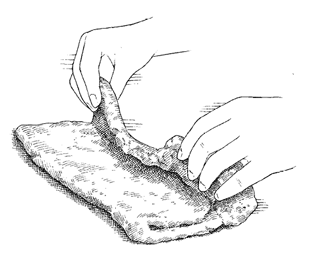
1.
Fold dough into thirds (like business letter).
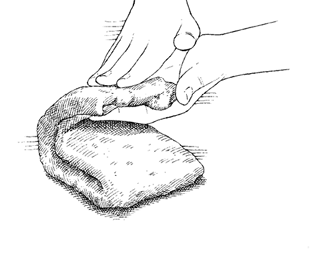
2.
Fold in ends of dough to form 4-inch square, then chill dough in freezer for 5 minutes.
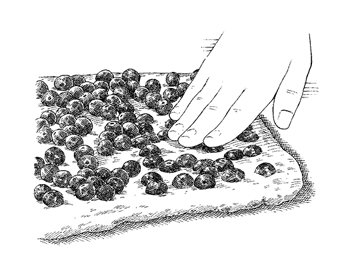
3.
Reroll dough into 12-inch square, then press berries into dough.
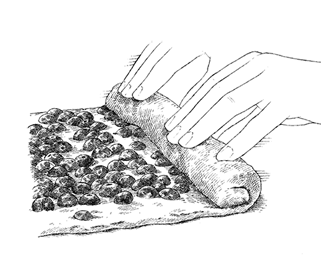
4.
Roll dough into jellyroll-like log to incorporate blueberries.
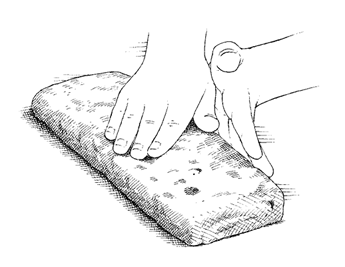
5.
Arrange log seam side down and press into even 12 by 4-inch rectangle.
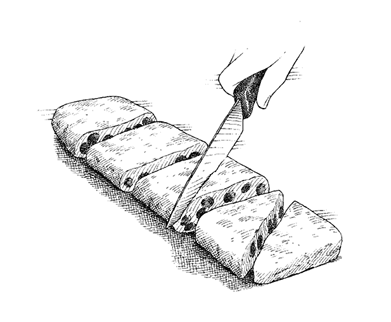
6.
Cut dough crosswise into 4 rectangles, then diagonally to make 8 triangular pieces.
MAKES 2 CUPS
Ultra-pasteurized heavy cream can be substituted but the resulting cream will be not as flavorful and tangy. This recipe can be halved or doubled as needed.
1¹⁄ | cups pasteurized (not ultra-pasteurized) heavy cream |
¹⁄ | cup buttermilk |
Combine cream and buttermilk in jar or measuring cup. Stir, cover, and let stand at room temperature until mixture has thickened to the consistency of softly whipped cream, 12 to 24 hours. Refrigerate; cream will continue to thicken as it chills. (Clotted cream can be refrigerated for up to 10 days.)
![]() WHY THIS RECIPE WORKS
WHY THIS RECIPE WORKS
The oatmeal scones served in a typical coffeehouse are so dry and leaden that they seem like a ploy to get people to buy more coffee to wash them down. We wanted rich toasted oat flavor in a tender, flaky, not-too-sweet scone. Whole rolled oats and quick oats performed better than instant and steel-cut oats, and toasting the oats brought out their nutty flavor. We used a minimal amount of sugar and baking powder, but plenty of cold butter. A mixture of milk and heavy cream added richness without making these scones too heavy. An egg proved to be the ultimate touch of richness. Cutting the cold butter into the flour, instead of using melted butter, resulted in a lighter texture. A very hot oven made the scones rise spectacularly, gave them a craggy appearance, and meant less time in the oven and therefore less time to dry out.
MAKES 8 SCONES
Rolled oats will give the scones a deeper oat flavor, but the quick-cooking oats will create a softer texture; either type will work here. Half-and-half is a suitable substitute for the milk and cream combination.
1¹⁄ | cups (4¹⁄ |
¹⁄ | cup whole milk |
¹⁄ | cup heavy cream |
1 | large egg |
1¹⁄ | cups (7¹⁄ |
¹⁄ | cup (2¹⁄ |
2 | teaspoons baking powder |
¹⁄ | teaspoon salt |
10 | tablespoons unsalted butter, cut into ¹⁄ |
1.
Adjust oven rack to middle position and heat oven to 375 degrees. Spread oats evenly on baking sheet and toast in oven until fragrant and lightly browned, 7 to 9 minutes; let cool on wire rack. Increase oven temperature to 450 degrees. When oats are cooled, measure out 2 tablespoons for dusting counter and set aside. Line second baking sheet with parchment paper.
2.
Whisk milk, cream, and egg in large measuring cup until incorporated. Reserve 1 tablespoon in small bowl for glazing and set aside.
3.
Pulse flour, ¹⁄
3
cup sugar, baking powder, and salt in food processor until combined, about 4 pulses. Scatter butter evenly over dry ingredients and pulse until mixture resembles coarse cornmeal, 12 to 14 pulses. Transfer mixture to medium bowl and stir in cooled oats. Using rubber spatula, fold in liquid ingredients until large clumps form. Mix dough by hand in bowl until dough forms cohesive mass.
4.
Dust counter with 1 tablespoon reserved oats, turn dough out onto counter, and dust top with remaining 1 tablespoon reserved oats. Gently pat dough into 7-inch circle about 1 inch thick. Using bench scraper or chef’s knife, cut dough into 8 wedges and place on prepared baking sheet, spacing wedges about 2 inches apart. Brush tops with reserved egg mixture and sprinkle with remaining 1 tablespoon sugar. Bake until golden brown, 12 to 14 minutes. Let scones cool on baking sheet on wire rack for 5 minutes, then transfer scones to wire rack and let cool to room temperature, about 30 minutes. Serve.
TO MAKE AHEAD:
After placing scones on baking sheet in step 4, either refrigerate them overnight or freeze for up to 1 month. When ready to bake, bake as directed. For frozen scones, do not thaw, heat oven to 375 degrees, increasing baking time to 25 to 30 minutes.
Add ¹⁄
4
teaspoon cinnamon to food processor with flour and ¹⁄
2
cup raisins to flour-butter mixture with toasted oats.
Reduce oats to 1 cup and toast ¹⁄
2
cup slivered almonds with oats in step 1. Add ¹⁄
2
cup chopped dried apricots to flour-butter mixture with toasted oats and almonds.
Toast ¹⁄
2
cup chopped pecans with oats in step 1. Omit sugar and whisk ¹⁄
4
cup maple syrup into milk mixture. When scones are cool, whisk 3 tablespoons maple syrup and ¹⁄
2
cup confectioners’ sugar until combined, then drizzle over scones.
Reduce oats to 1¹⁄
4
cups and toast ¹⁄
4
cup chopped hazelnuts with oats in step 1. Stir ¹⁄
2
cup chopped dried tart cherries into flour-butter mixture with toasted oats.
STORING BISCUITS, QUICK BREADS, AND MUFFINS
Most leftover biscuits, scones, and muffins can be stored in a zipper-lock bag at room temperature for up to 3 days. If they include perishable flavorings like bacon, it is best to refrigerate them. When ready to serve, just refresh them by placing them on a baking sheet and warming them in a 300-degree oven for about 10 minutes before serving.
![]() WHY THIS RECIPE WORKS
WHY THIS RECIPE WORKS
Traditional British scones are essentially fluffy biscuits. These scones should be sweet, but not too sweet, so that they can be enjoyed with jam and perhaps clotted cream. For a light, tender texture, we tried cake flour, but it made gummy scones. All-purpose flour, on the other hand, gave us light, feathery scones. A modest amount of sugar kept the sweetness level in check and there was no question we would rely on butter over shortening for best flavor. Heavy cream gave our scones a rich, not-too-dry character. A food processor made quick work of incorporating the butter into the flour; we stirred in the cream by hand and then lightly kneaded the dough before cutting it into wedges. We also found it was important to get the scones into the oven immediately after cutting them out for the best rise. While currants are traditional in British scones, we left them as optional.